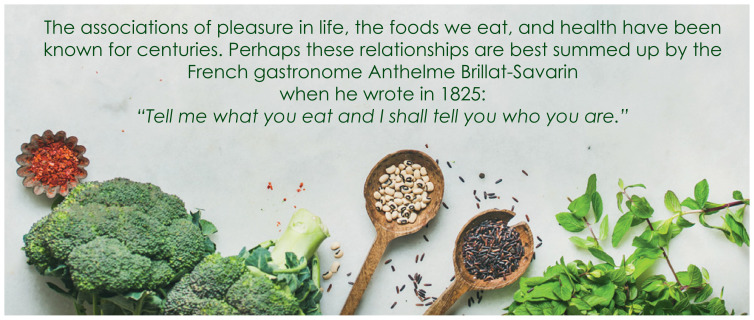With this issue of Missouri Medicine, the Journal concludes a series on diets and nutrition.1–7 The foods we eat are determined by a complex set of factors, including personal preferences, cultural and religious practices, co-morbid health conditions, availability and accessibility of foods, agricultural practices, and public policy.
Cultural and religious directives on foods have been in place for thousands of years, with recorded practices documented in the Bible and in ancient Egyptian texts. The recognition that the food we eat impacts health also dates to ancient times.8,9,10 Hippocrates, Asclepiades of Bithynia, Galen, and other Greek and Roman physicians wrote about diet interventions for health. The relationship between obesity and diabetes as well as recommendations for diet and physical activity for weight loss were also noted in ancient writings.
In addition to recognition of food and nutrition as contributing to health or causing disease, people have also used foods to enhance athletic ability and warrior status for centuries.11 In modern times, alterations in food content or amount (i.e. diets) are still used with goals of enhancing athletic performance, improving physical looks (i.e. weight loss), and for improving health.
The rise of modern nutrition science and dietary guidance started in the late eighteenth century and progressed into the early twentieth century with the advent of modern science in chemistry, thermodynamics, and physiology that led to the understanding of macronutrients (proteins, carbohydrates, and lipids), vitamins, energy balance, and digestion.12,13,14
Understanding science and the complex relationships between diet and health is critically important in order to develop nutrition guidelines that inform the public and guide public policy and nutrition programs. Unfortunately, there remain many gaps in our knowledge, partly because nutrition studies on eating patterns and their impact on health are difficult to perform and generalize to the population. Many studies are of short duration, small size, and rely on self-reported food intake.
Formal nutrition guidelines began in the nineteenth century, initially focusing on macronutrients and energy needs, and following with vitamin and micronutrient recommendations as these nutrients were identified and understood. The relationship between specific vitamins or minerals (e.g. vitamin C or iron) are more easily understood than more complex epidemiologic relationships between macronutrients and chronic disease (e.g. dietary fat and carbohydrate effects on cardiovascular disease).14
Modern food guidelines in the United States were first published in 1980 and are updated every five years, with the most recent published in 2020.15,16 These guidelines have evolved over the past four decades to move from a focus on specific components (fats, carbohydrates, protein) to an emphasis on “healthy eating patterns.” There is recognition that nutrition needs and metabolism change over the lifespan, and that eating is a pleasurable, social activity influenced by culture and the availability and affordability of healthy foods.
The food we eat should bring us both health and happiness. This is the underlying meaning of “you are what you eat.” Fad diets rarely are sustainable in bringing both health and happiness and may even contribute to development or exacerbation of eating disorders. The nutrition and diet papers in this series covered eating patterns, popular diets, and the importance of food and nutrition security. Our relationship to food is complex, but the consensus is that food should support both physical and mental well-being, and that the eating pattern most likely to achieve this outcome is one that is higher in plant proteins, fruits, vegetables, and whole grains while limiting saturated fats and added sugar. We also need to have a positive relationship with the foods we eat, and emphasis should be on a positive approach of choosing foods based on personal and cultural preferences rather than a negative approach of avoiding foods.
The associations of pleasure in life, the foods we eat, and health have been known for centuries. Perhaps these relationships are best summed up by the French gastronome Anthelme Brillat-Savarin when he wrote in 1825: “Tell me what you eat and I shall tell you who you are.”17
Footnotes
Betty M. Drees, MD, FACP, FACE, is Professor of Medicine, Department of Internal Medicine and Department of Biomedical and Health Informatics, University of Missouri-Kansas City School of Medicine, and President, Graduate School of the Stowers Institute for Medical Research. Brandon Barthel, MD, (above), is Assistant Professor of Internal Medicine and Program Director Section of Endocrinology and Metabolism, University of Missouri- Kansas City School of Medicine.
Disclosure
None reported.
References
- 1.Rakhra V, Galappaththy SL, Bulchandani S, Cabandugama PK. Obesity and the Western diet: How we got here. Mo Med. 2020 Nov–Dec;117(6):536–538. [PMC free article] [PubMed] [Google Scholar]
- 2.Mccalmon S, Galappaththy SL, Bulchandani S, Cabandugama PK. Fasting off “The COVID-19”. Mo Med. 2021 Mar–Apr;118(2):164–167. [PMC free article] [PubMed] [Google Scholar]
- 3.Clem J, Barthel B. A look at plant-based diets. Mo Med. 2021 May–Jun;118(3):233–238. [PMC free article] [PubMed] [Google Scholar]
- 4.McGaugh E, Barthel B. Review of the ketogenic diet and lifestyle. Mo Med. 2022 Jan–Feb;119(1):84–8. [PMC free article] [PubMed] [Google Scholar]
- 5.Nguyen B, Drees B. Food and nutrition security in clinical settings. Mo Med. 2022 Mar/Apr;119(2):167–72. [PMC free article] [PubMed] [Google Scholar]
- 6.Voss MM. Eating disorders & the primary care physician. Mo Med. 2022 May–Jun;119(3):242–9. [PMC free article] [PubMed] [Google Scholar]
- 7.De Almeida R, Kamath G, Cabandugama P. Food addiction in application to obesity management. Mo Med. 2022 Jul–Aug;119(4):372–8. [PMC free article] [PubMed] [Google Scholar]
- 8.Hwalla N, Koleilat M. Dietetic practice: the past, present and future. East Mediterr Health J. 2004;10(6):716–30. [PubMed] [Google Scholar]
- 9.Haslam D. Obesity: A medical history. Obes Rev. 2007;8(Suppl 1):31–36. doi: 10.1111/j.1467-789X.2007.00314.x. [DOI] [PubMed] [Google Scholar]
- 10.Yapijakis C. Hippocrates of Kos, the father of clinical medicine, and Asclepiades of Bithynia, the father of molecular medicine. Review In Vivo. 2009 Jul–Aug;23(4):507–14. [PubMed] [Google Scholar]
- 11.Applegate EA, Grivetti LE. Search for the competitive edge: A history of dietary fads and supplements. J Nutr. 1997 May;127(5 Suppl):869S–873S. doi: 10.1093/jn/127.5.869S. [DOI] [PubMed] [Google Scholar]
- 12.Carpenter KJ. A short history of nutritional science: Part 2 1885–1912. J Nutr. 2003 Apr;133(4):975–84. doi: 10.1093/jn/133.4.975. [DOI] [PubMed] [Google Scholar]
- 13.Jahns L, Davis-Shaw W, Lichtenstein AH, Murphy SP, Conrad Z, Nielsen F. The History and future of dietary guidance in America. Adv Nutr. 2018 Mar 1;9(2):136–147. doi: 10.1093/advances/nmx025. [DOI] [PMC free article] [PubMed] [Google Scholar]
- 14.Ridgway E, Baker P, Woods J, Lawrence M. Historical developments and paradigm shifts in public health nutrition science, guidance and policy actions: A narrative review. Nutrients. 2019;11(3):531. doi: 10.3390/nu11030531. [DOI] [PMC free article] [PubMed] [Google Scholar]
- 15.Schneeman BO. Evolution of dietary guidelines. J Am Diet Assoc. 2003 Dec;103(12 Suppl 2):S5–9. doi: 10.1016/j.jada.2003.09.030. [DOI] [PubMed] [Google Scholar]
- 16.U.S. Department of Agriculture and U.S. Department of Health and Human Services. Dietary Guidelines for Americans. 9th Edition. Dec, 2020. pp. 2020–2025. Available at DietaryGuidelines.gov https://www.dietaryguidelines.gov/resources/2020-2025-dietary-guidelines-online-materials.
- 17.Rössner S. Anthelme Brillat-Savarin 1755–1826. Obes Rev. 2007 Nov;8(6):531–2. doi: 10.1111/j.1467-789X.2007.00380.x. [DOI] [PubMed] [Google Scholar]




